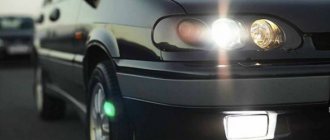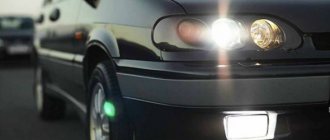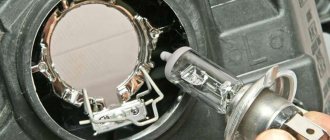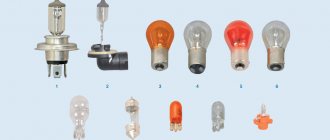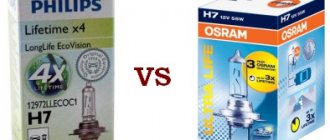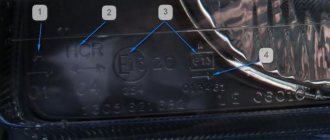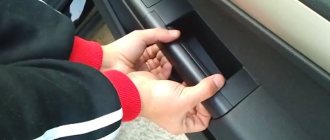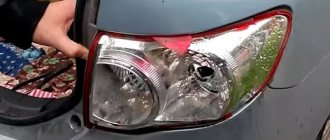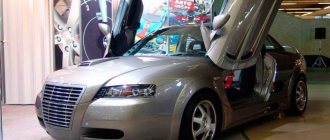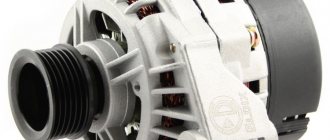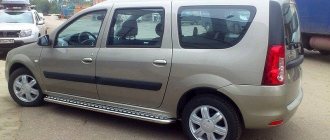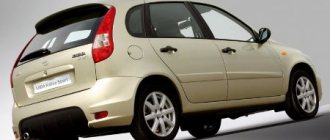Lighting elements in cars and their fastening and contact systems vary depending on several factors:
- country of car manufacturer;
- car brand;
- model year;
- purpose of the lamp in the design.
Thus, car lamp bases are not interchangeable and replacing a burnt-out lighting fixture turns into a rather complicated process. You have to understand the symbols, decipher the markings on a specific element, and even the same type of light bulb differs in performance characteristics. At the same time, the lack of a unified standard opens up opportunities for car enthusiasts who want not only to replace the unit, but also to upgrade their car lights, which is popularly called “collective farm tuning.”
Light bulbs according to traffic police laws
Regarding the legality of such measures, everything is far from clear, since regulatory authorities prohibit interference with the design of the car. In principle, these measures are not groundless, because most drivers strive to achieve maximum illumination of the roadway, which is to the detriment of oncoming drivers who are blinded by bright lights. The situation is contradictory, since on the one hand, even short-term blinding by oncoming headlights can lead to loss of control, and on the other hand, insufficient illumination of the road surface also increases the risk of accidents. In practice, the only way to make the road in front of a car more visible when illuminated by oncoming headlights is to increase the brightness of your own.
As a result, everything comes down to the pursuit of brightness and some states, including the Russian Federation, are trying to regulate this issue at the legislative level, maintaining a single standard for the level of emitted light, the degree of side illumination and the presence of a clearly defined boundary between the central and peripheral light spots. However, according to statistics, about 40% of all cars in the Russian Federation have lamps in the headlight design that were not provided by the car manufacturer . In most cases, this is not a reason for drawing up a protocol on violation of the rules by traffic police officers, since it is difficult to visually determine the non-compliance of the ED unit (operational documentation).
From July 1, 2021 in the Russian Federation, the legality of any changes made to the vehicle design that are not provided for in the operational documents will be assessed by the State Traffic Safety Inspectorate using the laboratory method in accordance with GOST 33670–2015. This means that everyone can legalize their auto-tuning if laboratory testing proves the safety of the changes made.
In the United States, crime bosses, by the way, don’t bother with such questions at all and are allowed to travel with any bells and whistles. In any case, even to install an original light bulb, you have to navigate the main types and modifications of car lamps, since installation and fastening methods, as well as power sources for car lights, are not unified.
Choosing light bulbs for headlights: how not to burn out
Are you looking for a new headlight bulb to replace a burned out one? Mikhail Kolodochkin has prepared a cheat sheet on watts, kelvins and “xenon effects”.
Has the lamp burned out? Don't tempt fate - buy a new one immediately!
It’s not difficult to choose the right type of lamp, especially if you’re holding a burnt one in your hands. And the seller will always tell you if you don’t want to study descriptions and catalogs. We advise you to choose products from reputable companies, of which there are not many: Philips (and its Narva brand), as well as OSRAM and GE. It is curious that it is almost impossible to buy an ordinary light bulb - they often go only to the assembly line. And on the shelves there are a variety of lamps with “improvements.”
Take a closer look at the labels and inscriptions so as not to buy something that is obviously unnecessary or worthless.
How to understand how long a lamp will last if the resource (Life time) is usually not indicated on the packaging?
The service life of halogen lamps with standard luminous flux is approximately 600 hours. It largely depends on voltage. The optimal is 13.2 V. Exceeding this value by only 5% results in a reduction in service life by 40% (but the luminous flux of the lamp increases by about 18%).
On the contrary, if the voltage is 5% lower, the service life increases by as much as 60%, but at the same time the luminous flux decreases by 10%. For comparison: the service life of gas-discharge (xenon) lamps is approximately 3,000 hours, light-emitting diodes (LED) - 10,000, and the latest organic light-emitting diodes (OLED) - as much as 30,000 hours.
There are “long-lasting” lamps - with a thicker filament or, say, with a special mixture of gases: xenon or krypton is added to slow down the evaporation of tungsten atoms from the filament. But in any case, as a rule, there is a relationship between the declared service life and the luminous flux: you shine better - you live less (reduction in service life is 10–50%), and vice versa.
Manufacturers sometimes resort to little tricks. For example, if a lamp says that it gives 50% more light and at the same time lasts twice as long, there is no deception - the company simply compares the new product with lamps of the previous generation by default.
Should the lamp packaging have a certification mark?
According to Russian legislation, packaging of automobile lamps must bear a conformity mark. It is often placed on stickers. But what definitely shouldn’t be there are inscriptions like “Not for use in Europe” or “Offroad use only”. In both cases, we are talking about lamps that no one has certified according to the UNECE Rules (Russian Technical Regulations are based on these Rules), which means that you and I cannot install them in car headlights.
Is it possible to install an LED lamp in a headlight instead of a halogen lamp?
Definitely not! Numerous oriental crafts, plastered on all sides with LEDs, theoretically cannot coexist with the design of a headlight designed for a specific lamp with a specific filament arrangement. It will be bad for both you and those around you. The only exception is one of the Philips lamps, in which the high-power LED is located in the same way as the filament in a regular lamp. Structurally, it fits perfectly into the headlight with H11, H8 and H16 sockets. But it is not allowed to be used for head lighting. In foglights - please. However, LEDs have one unpleasant feature: since they have a lower operating temperature, the headlights can fog up and freeze up.
When choosing a lamp, should you pay attention to inscriptions like 2600 K?
We see and distinguish objects best on a bright sunny day. The so-called daytime color temperature lies between 4000 and 6500 K. The closer the color temperature of the light from an artificial source to daylight, the more comfortable this lighting is: the eyes are less tired, the driver is not as tired. But such lamps do not illuminate the road well in rain and fog, because white light is better reflected from drops. In such weather, yellow lamps with a color temperature of less than 3000 K are more effective; They are usually installed not in headlights, but in fog lights.
To increase the color temperature, blue bulbs are used. For example, for Philips DiamondVision lamps it is 5000 K. It is curious that in some lamps the upper part of the bulb is colored solely for the sake of aesthetics. Thus, Philips ColorVision lamps tint the headlight glasses in one of four popular colors, while the beam of light is completely white.
Does it make sense to purchase a more powerful 100/90 W lamp instead of a standard 60/55 W lamp?
In no case. The standard wiring of a production car is not designed for high currents; the experiment is fraught with fire. Such lighting technology can only be used on cars specially prepared for competitions.
What do Beam Performance +60% or +50% Light mean? What are the negative consequences of using such lamps?
Such inscriptions promise that when using these lamps, individual control points in front of the car will be illuminated better than when using bulbs with a standard luminous flux. As for the negative, all lamps with similar declared effects usually have a shorter resource (Life time). And don’t forget that for every promised “plus” you will have to pay.
Can a halogen lamp marked “intense white xenon effect” shine like a gas discharge lamp?
This formulation in practice means that the lamp produces pure white light. But real gas-discharge lamps, usually called xenon lamps, are much brighter than halogen lamps.
Source: www.zr.ru
Some historical facts
The first headlights for Karl Benz cars in 1985 were ordinary kerosene stoves.
By the end of the century, kerosene light sources were replaced by acetylene lanterns, similar to locomotive lanterns, operating on the principle of a gas burner.
And only in 1910, the first headlights with the usual reflector, powered by a battery and working on the principle of Ilyich’s light bulb, were installed on Cadillac and Rolls-Royce.
Since then, the electrical energy source for lamps has remained unchanged, which cannot be said about the principle of their operation and design features that affect the main characteristics of lighting devices.
The best manufacturing companies
Many automobile companies are developing optics for their cars. But world-famous and reputable brands install optics on their equipment from companies that have been specializing only in a specific narrow segment of production for decades. The best brands that produce H7 lamps are:
- Osram;
- Philips;
- Bosch;
- Hella;
- Koito.
Products from Philips and Osram rank first in the popularity rating for quality and affordable price. The cost of the kit is not included in the budget category, but it pays off with a long service life and better lighting parameters. Philips lamps are manufactured from quartz glass in factories in the Netherlands and since 1996 in Pabianice, Poland.
The characteristics and quality of lamps from Hella and Bosch fully correspond to the declared ones. A special feature of the lamp design is the precise marking of the optics, which must be applied both to the base and to the technical passport.
The Japanese manufacturer Koito produces a full line of automotive lighting; the models have an increased lifespan that exceeds the stated characteristics.
Types of car lamps
Based on these criteria, several types of electric lamps used in the automotive industry are distinguished.
Incandescent
They are a tungsten filament in a glass flask, from which the air has been evacuated as much as possible. When voltage is applied to the opposite ends of the filament, the tungsten heats up, accompanied by the emission of photons of light in the visible spectrum. Due to insufficient power and short service life, as well as luminous warmth of up to 3200 K for headlights, this type of car lamps is used only in vintage vintage cars. And in modern cars it is used to illuminate the interior and instrument panel.
More details about each type
Each type of lamp has its own resource and requires replacement from time to time. To do this, you need to remove the burnt out lamp, go with it to the store, where they will help you choose a similar lamp. When choosing a lamp in an online store, help will not come automatically. To make the correct choice, you need to study the type of burnt-out lamp and the type of base. All this information is indicated on the lamp base. Lamps in front of the car are used in:
- high or low beam headlights;
- fog lights;
- direction indicators;
- side lights.
Types of car sockets
To hold the lamp in place and seal the bulb, a base is needed that has contacts for connecting to the power source. Depending on many factors, plinths vary in shape and size of structural elements.
With protective flange
He's a focusser. It is used in headlights, since the studs on the flange are located in exact accordance with the mounting grooves. This allows you to achieve the same focusing of the beams in the left and right headlights with a strict angle of inclination. Attached using bolts or a pressure spring located at the rear of the headlight housing. In fog lights, the filament coil, gas bulb or LED panel is located perpendicular to the reflector. Connection to contacts is made using terminals.
Soffit
The shape resembles voltage fuses. This arrangement of the plinths allows these light sources to be installed in flat structural elements. Used to illuminate license plates, instrument panels, interiors, and trunks.
Pin
They are bayonet. Similar to threaded ones, but the function of the thread is performed by one or more pins. The pins can be offset in height and radius. Fixation occurs by turning the lamp 10–15 degrees clockwise until it stops. The contact is the metal body of the base and one or two solders at the end. It is used in all types of lighting, except for headlights, most often for direction indicators, brake lights, and side lights.
With glass base
There are no metal fasteners in such a lamp, and retention in the seat occurs due to fixation with a spring clip in the socket. Installed in side lights, emergency lighting, dashboard lighting and anywhere else where a lot of power is not needed.
Main conclusions
When repairing a headlight, it is imperative to know the type of car lamp base with which it is equipped.
- Labeling of elements can be carried out according to the domestic (GOST) or European system, depending on the manufacturer.
- The letter designation informs about the type of lamp and the type of base, and the digital designation informs about its size or diameter.
- Classification can also be made by the number of contacts.
- In car headlights, halogen, gas-discharge and LED types of lamps are most often used.
- The type of base can determine the purpose of the light source when equipping vehicle lighting systems.
In the modern automotive industry, more and more attention is paid to LEDs and less and less to classic incandescent lamps. New car models place higher demands on the technical characteristics of not only the headlight design, but also the lamps used in them.
Previous
Bases and socketsHow to choose a lamp with a G13 base
Next
Bases and socketsFeatures of the e14 base for lamps and its differences from e27
Marking and designation of car lamps
By number of contacts
In some markings, at the very end, a small Latin letter indicates the number of contacts in the base according to the principle of the first letter of the Latin calculus:
- s (single) - 1;
- d (duo) - 2;
- t (tres) - 3;
- q (quatro) - 4;
- p (penta) - 5.
An example is the common P45t socket, where the letter t means that the light bulb is powered through three contacts.
By type of base
According to GOST 2023-88, adopted back in Soviet times, the marking of lamps does not always contain information about a specific type of connecting system. For example:
- AKG is an abbreviation meaning that the device is an automotive quartz halogen lamp;
- A - a letter informing only about whether the lamp belongs to a vehicle;
- AMN - auto lamp, where the letters MN indicate miniature sizes;
- AC is the only case in which the letter C indicates a soffit base.
With the European standard ECE, everything is somewhat better. Separate designations have already been highlighted here for maximum information content of all design features of the lighting device, where:
- H - halogen lamp;
- T - miniature;
- R - standard with a base diameter of 15 mm.
With regard to the specific type of base, according to European markings, there are:
- P - flanged;
- W - glass;
- BA - bayonet, with symmetrically located pins;
- BAY - bayonet type, with pins offset in height;
- BAZ - bayonet, with pins offset along the radius and height;
- G - pin;
- E - threaded.
If the lamp is made in the USA, then American DOT standards provide for the following designations:
- HB1 and HB2 - halogen, double-filament lamp;
- HB3 - single-strand high beam;
- HB4 - single-filament low beam;
- D1R , D1S - gas-discharge, first generation;
- D2R , D2S - second generation gas discharge.
The letters S and R indicate lens and reflector types of optics.
What can you learn from headlight markings?
The required minimum of tagged information usually includes:
- properties, type and technology of lamps used;
- identification of a headlight by the nature of its use;
- road illumination level created by the device;
- the name of the country that authorized the use of this headlight and approved its technical conditions and certificate of conformity to the sample presented for testing;
- additional information, including features of the cars on which this light device is used, release date and some other characteristics.
Markings are not always unified with any international standard, but the bulk of the codes approximately correspond to the generally accepted set of abbreviations.
Location
There are two possible cases of marking location: on the protective glass of the optics and on the back side of the plastic headlight housing.
The second method is used when it is possible to replace glass during operation without discarding the headlight assembly, although there is no certainty on this issue either.
Sometimes additional information is applied in the form of stickers. This is not so reliable if there is a legal need to verify the headlight’s compliance with established requirements, especially since counterfeiting such stickers entails liability under the law.
The consequences of using headlights that deviate from the certificate can be quite severe.
Decoding abbreviations
There are practically no directly readable inscriptions in the markings. It contains only symbols that require interpretation using special tables and standards.
- The location of the device and the direction of its action are encoded by the symbols A, B, C, R and their combinations like CR, C/R, where A means head or side light, B is fog light, C and R are low and high beam, respectively, when combined use - combined device.
- Depending on the type of emitter used, the letters H or D are distinguished by coding, indicating the use of classic halogen lamps or gas-discharge lamps, respectively, placed before the main marking of the device.
- The regional marking includes the letter E, sometimes deciphered as “European light”, that is, a light distribution approved in Europe. DOT or SAE for American-style headlights that have a different luminous flux geometry, and additional digital symbols to accurately indicate the region (country), there are about a hundred of them, as well as local or international quality standards that a given country adheres to, usually global ISO.
- The direction of travel adopted for a given headlight must be marked, usually with an arrow pointing to the right or left, while the American standard, which does not provide for asymmetry of the light beam, does not have such an arrow or both are present at once.
- Next, less essential information is indicated, the country of manufacture of the light device, the presence of lenses and reflectors, the materials used, the class of luminous flux, the angles of inclination in percentage for the normal direction of the low beam flow, the compulsory homologation symbol of the type.
All information for decoding takes up a significant amount of space, which is complicated by the presence of internal standards among manufacturers. The presence of such unique markings can make it possible to judge the quality of the headlight and whether it belongs to one of the leading manufacturers.
Compatibility table for sockets and car lamps
Moreover, in H and NV , each type has corresponding dimensions, in which the radius of the bulb and base is strictly regulated. Dimensions are shown in the picture.
This means that LED analogues with similar markings ideally also have the corresponding dimensions in millimeters. Some Chinese versions with the same designations may not coincide with the seat and may not even fit into the headlight housing if the optics are located close to the factory lamp, and the bulb of the analogue is a couple of millimeters longer.
H7 lamps with increased luminous flux
High-brightness H7 car lamps provide better quality of light. You can often solve the problem of dim lighting with these bulbs, without having to change the headlights or repair the reflectors.
Osram H7 Night Breaker Unlimited
Bright light is the main difference between these lamps.
The manufacturer promises an increase in brightness by 110%, but the price will be noticeably higher. The light quality of this option is really good, highlighting both the lane and the roadside. The brightness is high, color rendition is also high quality.
The service life is noticeably shorter than that of the standard. Excessive voltage or strong vibration of the engine especially affects the service life. But in general, the lamps are decent and provide safe driving in the dark.
Precise headlight alignment is important for these bulbs. If it is knocked down, the lamps will overextend the oncoming traffic.
PHILIPS H7 Vision Plus +60%
Due to proper light distribution, the light improves greatly.
They shine worse than previous lamps, but the difference is stated to be 50% less. At the same time, it should be noted that the quality is good and the ride is comfortable due to the fact that the light is distributed correctly and illuminates all the necessary areas.
In the Philips line there are models with a large increase, but the difference with the lamps in question is small. If we consider that the +60% model lasts much longer than products with higher brightness , then it becomes the most preferable.
If the light is well adjusted and the reflectors and lenses are in good condition, the lamps will be enough for a comfortable ride.
Video comparison: Philips LongLife EcoVision vs Philips VisionPlus 60%
Bosch H7 Plus 90
A good option with a good resource and high performance.
These lamps really shine 90% better than the standard Bosch model. At the same time, the brightness is comfortable and driving with the light will be convenient. Experts highlight the excellent light distribution of the bulbs; both the roadway and the side of the road are equally visible.
With good brightness, the product lifespan is an order of magnitude longer than average. During normal operation they operate only slightly less than standard .
To achieve a better effect, the headlights should be adjusted. It is advisable that the car have a corrector, since under load the luminous flux rises and blinds oncoming drivers.
Where are the markings found?
Manufacturer codes and all necessary information are indicated in two places. Where to look for the markings on the headlight:
- on the headlight glass;
- on the plastic housing under the hood.
On older car models, the code is found on the underside of the body. To view all the information, you must completely dismantle and turn over the light device. The designation of the car is found in the form of stickers, which come off over time, after which they cannot be restored.
Applying a sticker that does not correspond to reality and installing unspecified lamps is punishable by an administrative fine and the issuance of an order to eliminate the malfunction.
How to read European symbols?
In the countries of the Old World, there is a single ECE standard, in which everything is “decided” by the capital letters of the English alphabet. T – miniature base lamp; R – lamp with a 15 mm base and a bulb with a diameter of no more than 19 mm; P – lamp with a 15 mm base and a bulb with a diameter of up to 26.5 mm; The W after the number indicates the power of the light bulb (60/55 W), and if it is not there, the number indicates the model number; The W at the beginning of the marking tells the buyer that the lamp is equipped with a glass base. H – indicates that the lamp is halogen; Y, which is located in front of the number, means that the lamp has an orange bulb color.
Bases by marking
Next, you need to choose a lamp with a suitable base. The most common base is E27; it can be considered standard. But lamp manufacturers are moving away from this solution and using other types.
Type E sockets are also called “Edison sockets”. They have a threaded fastening and the numbers following indicate its diameter. As already mentioned, the most common is E27, followed by E14, also known as “minion”. You will see such a baby in sconces, table lamps, etc.
Anyone who has encountered a suspended ceiling and point light sources has probably seen light bulbs without threads - with pins. The “G” family has pins as contact pins; the number indicated after the letter is the distance in millimeters between them.
For example, a fairly popular connector for halogen lamps - G5 has 5 millimeters between the terminals, and fluorescent tubular lamps have 13 millimeters between their contacts and the base is called G13, both of which are actively being replaced by representatives of LED lighting.
The name may contain more than one letter. For example, a fluorescent lamp starter has thickening at the ends, with a distance of 10 mm between the contacts. This modification is called GU10; there are also lamps with this mount.
Above are the most common types of bases. There are many rare variations of bases; we have indicated those that you encounter in everyday life.
They have two types of markings, international and European. Now they are switching to the first designation for car bulbs, otherwise there will be quite a lot of confusion with the labeling.
Brief technical features
A lamp base for a car is an integral element that is required to firmly fix the lamp in the device socket. In addition, this part provides a continuous supply of electricity through its contacts to power the lighting device. Some constant elements provide for the presence of gas; a leak may occur as a result of incorrect selection of the device.
Socles are divided according to the type of contact devices and can be:
- With petals
- Monolithic sites
- Wire pins.
The base as the base of the lighting apparatus is intended to ensure reliable sealing of the bulb itself and protection from the effects of aggressive external conditions.
When it comes to diode devices, fixing the light bulbs for cars is not necessary. In other types of auto lamps, such as halogen, xenon and incandescent lamps, a sealed connection must be present.
Each modification of the base element has an individual index, which can differ in both alphabetic symbols and numbers. All values indicate specific product parameters. To understand the decoding of the types of car light bulbs, you should study the table and lists of definitions.
Brief purpose:
- The device securely holds the light fixture in a mounting-type socket.
- It is a conductor of electricity coming from the source to the filaments.
- Provides sealing of the lamp body, protecting the device from the influence of external factors.
VIDEO: Main types of bases
Classification and types
At the time of the existence of the USSR, 4 main abbreviations of light bulbs for vehicles, which were produced in this territory, were recorded in state regulations:
- AMN is an abbreviated name for auto lamps with miniature dimensional parameters.
- AKG - designates such lighting devices for cars as halogen products and quartz.
- AC - the abbreviation is listed for soffit lighting equipment;
- A - standard type of equipment intended for vehicles.
Typically, the subsequent digital symbols, which are indicated after the letters, indicate the amount of power of the lighting equipment and the serial number of the manufacturer. However, this marking can only be found on domestically manufactured vehicle lighting devices. One of the main disadvantages of indexing is the absence of a certain type of automobile lamp in the code. Today, such ciphers are practically not used.
Modifications of optics and cartridges
At the moment, most often in the automotive industry and the sale of spare parts there are products with other designations. The updated rules for creating symbols have had a positive impact on the formation of a unique index that complies with standardized ECE standards.
To make it easier to understand the product, each element is designated by the following abbreviation:
- H - symbol indicates halogen lighting devices;
- W - a product that includes components consisting of glass;
- R - halogen lamps with a base component and a bulb, the diameter of which is 15 cm;
- Y is an abbreviation for a car lighting device that contains an orange-colored bulb;
- T - lamps for transport of this modification have compact dimensional parameters.
In addition, there are types of car lamp bases that differ in the individual number of contact elements, which varies from 1 to 5 units.
The variety of classification divisions can be determined from the list with pictures. However, you should know that each type of product completely depends on the technical characteristics of the fastening.
Individual classification and labeling
In addition to the already indicated abbreviations of devices intended for lighting, devices have individual classification and marking, which is created based on the type of connecting socket.
Each type of connection system is designed in such a way that it is not possible to screw or insert lamps into sockets of inappropriate classification.
